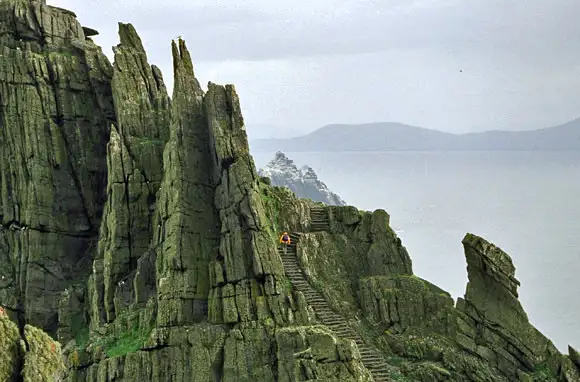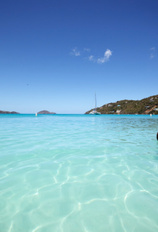
Eight miles off the west coast of Ireland lies an island unlike any other. It’s barely a footnote in most guidebooks. It’s so far off the beaten path you have to rent a fishing trawler and a captain just to get there. And it’s where I find myself this warm spring morning, preparing to disembark from Captain Pat Joe Murphy’s rumbling trawler Shelluna and watching my step on the slippery pier of Skellig Michael.
Thousand-year-old stone steps—about 600 of them—greet me. They corkscrew up and out of sight, vanishing toward an abandoned monastic settlement barely changed since its pinnacle in the 12th century. There, 20-foot-tall stone beehive-shaped huts loom over the few hardy souls who opt to make the 700-foot climb to the top of the island.
I’m one such soul, and I may as well have the place to myself. Now a World Heritage Site, Skellig Michael is limited to about 300 visitors a day even in the busy summer travel season. Here in the spring, it’s nearly empty. There’s no better way to see it, or its darker twin Small Skellig half a mile east across the Atlantic.
From the sixth century to the 12th, Christian monks lived, worked, and died here on this island. In these buildings. On this exposed peak. Today anyone can pay 35 euros to brave the choppy ocean voyage and have a look at their legacy. It’s a time machine back to ancient Ireland.
Why Skellig Michael?
It began with a photograph. I saw a picture of this windswept Atlantic island and I knew immediately I had to find out who built those stone steps and where they led. That brought me to The Skellig Story by local ornithologist and author Des Lavelle.
“There were monastic settlements on almost every island off the west coast,” Lavelle would later tell me. “The uniqueness of Skellig Michael is that the monastic architecture survived.” It survived because of the island’s remote location. Unlike similar outposts closer to the coast, there was no strategic reason to occupy the Skelligs—and no natural resources to raid and bring back to the mainland, either.
This isolation also gave birth to the Skelligs’ greatest curiosity: the whirring hive of avian life that is Small Skellig. Like a jagged, gothic-spired half-cousin of King Kong’s Skull Island, Small Skellig rises unsteadily from the Atlantic only to be clobbered by wave after wave of gulls and gannets, fulmars and kittiwakes, storm petrels and puffins and razorbills. It is to birdwatchers what Skellig Michael is to wannabe Indiana Joneses like me.
Most boat trips to the Skelligs drop you off before lunch and pick you up about three hours later. In between, you’re left alone to explore the empty island at your own pace—without turnstiles or guard rails. There aren’t any ticket takers or trinket shops or hot dog stands, either. They don’t run places this way in the U.S., and it’s too bad. The freedom here is part of what makes it special.
Getting to Skellig Michael
The closest international airport to Skellig Michael is Shannon, served by most major transatlantic carriers, including Aer Lingus. From there it’s a three-hour, 122-mile drive to the gateway town of Portmagee, located on the Iveragh Peninsula just off the famous Ring of Kerry. Then there’s the hour-long boat ride just to reach the steps. In short, there’s no easy way to get to there, and I’m not convinced that’s a bad thing. Let the other tourists kiss the Blarney Stone while you explore a more authentic, less-crowded side of the island.
I made my Skellig experience part of a larger Ireland trip booked through Aer Lingus Vacations, which netted me airfare, a Dan Dooley rental car, and six nights’ of B&B vouchers for accommodations across the country for about $800 a person. By my calculations I saved about $400 going this route, and I still got to choose from 1,300 Irish Tourist-board approved places to stay. You get a book with a map and description of every property. It’s not difficult to find availability during the low-season (April and May, for example), but it gets harder the closer you get to summer. For the Skellig Michael portion of the trip I used two of my B&B vouchers at the Beachcove B&B in St. Finian’s Bay. You’ll find it at the end of a single-lane road that twists through the coastal hills, stitched together by stone walls and emerald grass.
Renting a car in Ireland is tricky, and also possibly the priciest part of the entire trip. I tried to go the cheap route and opted for a standard transmission car; it only took a few minutes before I was back at the rental counter upgrading to an automatic. The problem is one of coordination: driving on the left side of the road and shifting in and out of gears is a nightmare if you’re not used to it. It costs more to upgrade to an automatic, but I found it was worth every cent for the safety factor alone.
In many countries, renting with your credit card will also get you all the rental car insurance you need. This isn’t necessarily the case in Ireland. Check with your auto insurance and credit card companies before you go to find out what is and isn’t covered by your policy. You may need to purchase Collision Damage Waver (CDW) even if you normally decline rental car coverage.
There’s any number of boats willing to take you from the pier at Portmagee to the Skelligs. I chose Pat Joe Murphy’s Shelluna on a recommendation from Bridie O’Conner—my B&B’s innkeeper—and I can’t complain with the choice. Murphy’s 35-euro charge (you pay on the boat the day of the trip) is the same as Des Levelle’s, who operates his boat trips from the visitor center on nearby Valentia Island. Both depart between 10:30 and 11:00 a.m. from mid-April through mid-September, weather permitting.
It’s hard to predict when weather will permit, though. Even in the summer months entire weeks pass when the water is too choppy to reach the islands. On those days, many visitors settle for the Skellig Experience Visitor Centre on Valentia Island. Its museum exhibit and brief video are an underwhelming substitute, but they’re a decent extension of the real thing if you’re lucky enough to make it to the islands. But beware of the Visitor Centre’s “Round-Skellig” cruise—it takes you around the Skelligs, not to them.
Because of the seasonal and weather-related limitations, it’s hard to plan a trip to the Skelligs. That’s where a flexible trip package like the Aer Lingus one I booked becomes invaluable. You can adapt to a changing itinerary while keeping costs flat because your biggest expenses—lodging and transportation—have already been paid up front.
The best months to go are April, May, and September. These are off-peak for both crowds and prices. You can save a lot of money and some major headaches by traveling when the Ring of Kerry isn’t swollen with tourists and tour buses. Accommodations are easier to come by then, too.
If you do get to be one of the lucky few to reach the Skelligs, don’t take it for granted. Stop and marvel at these islands—home to historical and natural wonders unmarred by the scourge of mass tourism.
We hand-pick everything we recommend and select items through testing and reviews. Some products are sent to us free of charge with no incentive to offer a favorable review. We offer our unbiased opinions and do not accept compensation to review products. All items are in stock and prices are accurate at the time of publication. If you buy something through our links, we may earn a commission.
Related
Top Fares From
Today's Top Travel Deals
Brought to you by ShermansTravel
Kenya: 14-Night Tour, Incl. Tanzania &...
smarTours
 vacation
$7125+
vacation
$7125+
7-Night Caribbean Round-Trip Cruise From Orlando:...
Norwegian Cruise Line
 cruise
$739+
cruise
$739+
Ohio: Daily Car Rentals from Cincinnati
85OFF.com
 Car Rental
$19+
Car Rental
$19+



